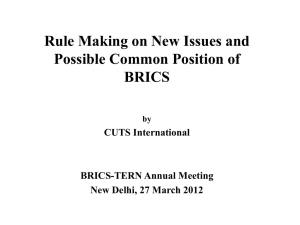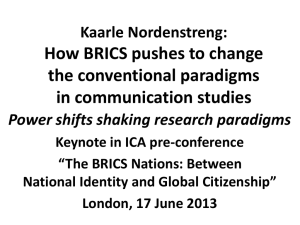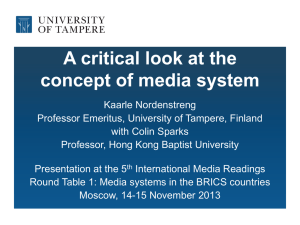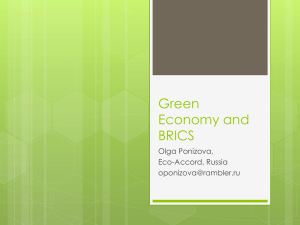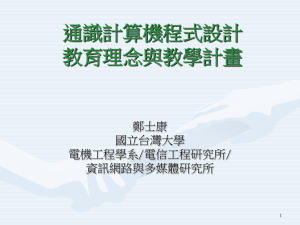David A. Gantz - Stanford Center for International Development (SCID)
advertisement
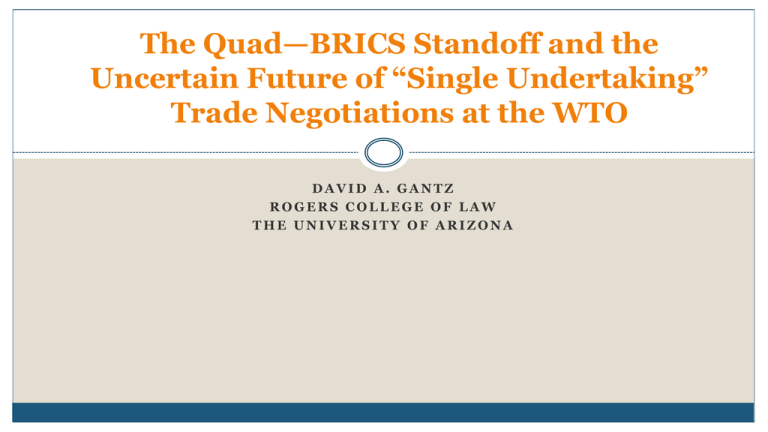
The Quad—BRICS Standoff and the Uncertain Future of “Single Undertaking” Trade Negotiations at the WTO DAVID A. GANTZ ROGERS COLLEGE OF LAW THE UNIVERSITY OF ARIZONA Introduction 2 Quad—BRICS split has all but destroyed the Doha Round Despite Bali’s limited success with trade facilitation and some agricultural issues, no consensus has emerged for pursuing other aspects of Doha Development Agenda Members can’t even agree on a 7th Appellate Body member Standoff continues despite the potential economic benefits of a successful conclusion of Doha Downside risks of failure, resulting protectionist policies may be $570$800 billion in lost trade Stanford Center for Int'l Development, April 24-25, 2014 Introduction: Structure of the Paper 3 II—Seattle and the Rise of the BRICS III—Factors Contributing to the Doha Round Failure IV—Role of Quad—BRICS Split V—Bali Ministerial: Too Little Too Late? VI--Conclusions Stanford Center for Int'l Development, April 24-25, 2014 Debacle in Seattle and the Rise of the BRICS 4 Long history of divisions between developed and developing nations Permanent Sovereignty over Natural Resources Charter of Economic Rights and Duties of States Trade and Development section of GATT Unhappiness with some elements of Uruguay Round Agreements Seattle in retrospect Too soon for another round given UR implementation challenges? Unwillingness of US and EU to address major areas of developing country concerns Carryover of standoff over choice of WTO director-general Stanford Center for Int'l Development, April 24-25, 2014 Debacle in Seattle, Cont’d 5 Loss of US and EU influence with developing nations, especially Brazil, India and China Lack of Quad enthusiasm for further reduction of agricultural subsidies (especially cotton), DFQF treatment for LDC exports (Often unarticulated) frustration by many developing countries with lack of access to BRICS agricultural and industrial markets Stanford Center for Int'l Development, April 24-25, 2014 Events Leading to the Doha Round Failure 6 Unhappiness among many developing country Members with fruits of the Uruguay Round Slow Quad implementation of Agreement on Textiles and Clothing Complexities of implementing TRIPS, TBT and SPS in particular Continued broad use of unfair trade practice laws by Quads, particularly the US Unrealistic expectations regarding Members’ ability to implement the Doha Declaration given lack of consensus on elements Stanford Center for Int'l Development, April 24-25, 2014 Doha Failure, cont’d 7 Ongoing disagreement over key issues Reduction of Quad agricultural subsidies and high agricultural import tariffs BRICS’ refusal to open agricultural markets and provide greater NAMA US “early harvest” on cotton subsidies and market access Extent to which special and differential treatment would be provided, particularly to countries (Brazil, China) that many believe no longer merit such treatment Expansion of BRICS’ services market access India and China’s insistence on being able to protect small farmers with high tariffs and safeguards going beyond bound levels Stanford Center for Int'l Development, April 24-25, 2014 Role of Quad—BRICS Split 8 Evidence of an unbridgeable divide on noted issues Negative impact of other factors Fear of increasing Chinese exports Lukewarm support by business groups, because of failure of Doha to address such issues as supply chain management, investment, competition law and others where RTA were considered more promising General lack of political will and leadership in both developed and developing country Member governments Expansion of industrial policies, again in both developed and developing Members Often understated but real disagreements between the BRICS and other MICs and LDCs Stanford Center for Int'l Development, April 24-25, 2014 Role of Quad—BRICS Split, Cont’d 9 Rise of influence of other middle income countries, and shift of negotiations from a few world powers to G-20 beginning with Cancun Continuing concerns over lower growth resulting from world-wide recession and questionable economic policies, particularly in Brazil and India, that discourage trade, innovation and economic growth Brazil: GDP growth reduced from 7.5% in 2010 to est. 1.8% in 2014 China: over 10% to 7.3% est. for 2014 (annualized <6% for first quarter) India: 6.1% est. for 2014 (down from 10.4% in 2010) Russia: 2% est. for 2014 (effect of Crimea invasion and sanctions?) South Africa: 2.3-2.5% (down from 2.8% est. in January) Stanford Center for Int'l Development, April 24-25, 2014 Role of Quad—BRICS Split, Cont’d 10 Disagreements among the US, EU and Japan over level of reductions of agricultural subsidies and agricultural tariffs (including tariff peaks) BRICS opposition to plurilateral agreements that would not provide MFN treatment, and Quad’s increasing concerns over “free rider” problems in TISA and ITA in particular Stanford Center for Int'l Development, April 24-25, 2014 Bali 2013 Ministerial: Too Little, Too Late? 11 Trade facilitation agreement could be a major step if widely implemented, whereby worldwide income could increase by at least $40 billion annually, most in developing countries, and world GDP increase by $1 trillion Transparency (leading to reduced corruption) Reduced discrimination against foreign goods Stakeholder right to comment on draft regulations and seek legal redress Streamlining existing border and procedures Expedited treatment for courier shipments Expanded rule of law in related areas Stanford Center for Int'l Development, April 24-25, 2014 Bali Ministerial, Cont’d 12 Many uncertainties remain Will it require eight or more years for the TFA to enter into force, as with 2005 TRIPS amendment? Will developed Members provide the necessary technical assistance and training? Will developed country Members, particularly LDCs be able to overcome opposition of national stakeholders, including well-entrenched bureaucracies, to improved procedures and reduced corruption? Stanford Center for Int'l Development, April 24-25, 2014 Bali Ministerial, Cont’d 13 Modest gains on agriculture “Food Security” through open-ended “peace clause” for Indian and other subsidies to small farmers, under Agreement on Agriculture Improved calculation of tariff-rate quotas, preferential rules of origin for LDCs, DFQF market access for LDCs (all hortatory rather than binding) Lack of progress on elimination of cotton subsidies and import duties (affecting mostly the US but also China) No changes in Quad agricultural subsidies, which likely disrupt world trade far more significantly than anything India or most other developing countries could afford Stanford Center for Int'l Development, April 24-25, 2014 Bali Ministerial, Cont’d 14 A step toward completing Doha, or confirmation of the death of the single undertaking, or a basis for other piecemeal progress on noncontroversial issues? Freer trade in environmental goods (at the WTO or in APEC?) Shift in focus toward protecting past agreements Efforts to forge stronger links between RTAs and the WTO Continuing expansion of plurilateral trade agreements where free rider problem can be avoided (e.g., TISA as an “economic integration agreement” under GATS, Art. V) Seeking out other areas for “pragmatic negotiation initiatives” Further (so far unsuccessful efforts) to establish greater WTO oversight over RTAs Stanford Center for Int'l Development, April 24-25, 2014 Conclusions 15 Quad—BRICS divide doesn’t seem capable of resolution in a broad sense in the foreseeable future WTO will continue to play a vital role in enforcement of existing agreements, including but not limited to the DSU Focus of trade liberalization negotiations will continue a decade-long shift toward RTAs, with the willing, both developed and some developing, Member, actively participating while others sit on the sidelines Many Members and their stakeholders will become even more convinced that if they wish to deal with cutting edge issues—e-commerce, global supply chain issues, competition, SOEs and perhaps information technology—it will not be through multilateral trade negotiations Stanford Center for Int'l Development, April 24-25, 2014 Conclusions 16 Major developed Members, including all of the Quads, will continue their preoccupation with negotiating and implementing “wide and deep” RTAs Trans—Pacific Partnership EU—Canada EPA EU—Japan FTA Transatlantic Trade and Investment Partnership Some developing Members, particularly China, will pursue a “shallower” approach Regional Comprehensive Economic Partnership China—ASEAN FTA ASEAN Community 2015 Success in meaningful RTA negotiations is anything but guaranteed Stanford Center for Int'l Development, April 24-25, 2014
